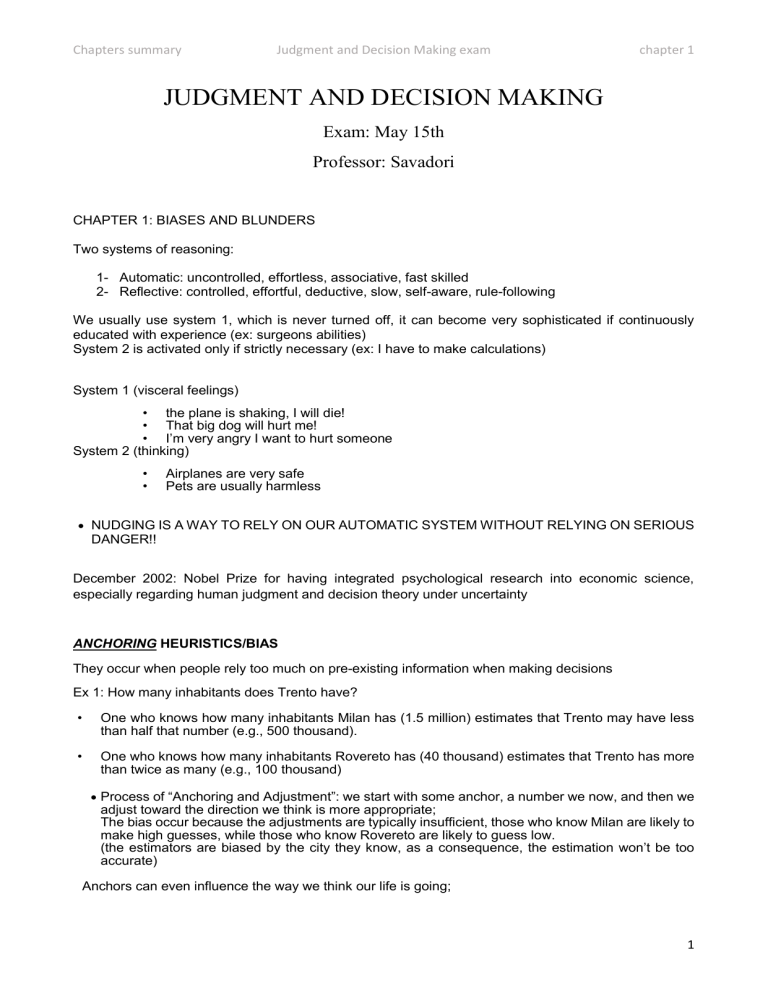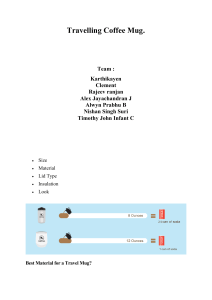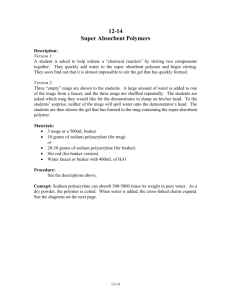
Chapters summary Judgment and Decision Making exam chapter 1 JUDGMENT AND DECISION MAKING Exam: May 15th Professor: Savadori CHAPTER 1: BIASES AND BLUNDERS Two systems of reasoning: 1- Automatic: uncontrolled, effortless, associative, fast skilled 2- Reflective: controlled, effortful, deductive, slow, self-aware, rule-following We usually use system 1, which is never turned off, it can become very sophisticated if continuously educated with experience (ex: surgeons abilities) System 2 is activated only if strictly necessary (ex: I have to make calculations) System 1 (visceral feelings) • the plane is shaking, I will die! • That big dog will hurt me! • I’m very angry I want to hurt someone System 2 (thinking) • • Airplanes are very safe Pets are usually harmless NUDGING IS A WAY TO RELY ON OUR AUTOMATIC SYSTEM WITHOUT RELYING ON SERIOUS DANGER!! December 2002: Nobel Prize for having integrated psychological research into economic science, especially regarding human judgment and decision theory under uncertainty ANCHORING HEURISTICS/BIAS They occur when people rely too much on pre-existing information when making decisions Ex 1: How many inhabitants does Trento have? • One who knows how many inhabitants Milan has (1.5 million) estimates that Trento may have less than half that number (e.g., 500 thousand). • One who knows how many inhabitants Rovereto has (40 thousand) estimates that Trento has more than twice as many (e.g., 100 thousand) Process of “Anchoring and Adjustment”: we start with some anchor, a number we now, and then we adjust toward the direction we think is more appropriate; The bias occur because the adjustments are typically insufficient, those who know Milan are likely to make high guesses, while those who know Rovereto are likely to guess low. (the estimators are biased by the city they know, as a consequence, the estimation won’t be too accurate) Anchors can even influence the way we think our life is going; 1 Chapters summary Judgment and Decision Making exam chapter 1 Ex 2: College students were asked (a) How happy they were, (b) How often were they dating. When the two questions were asked in this order the correlation was quite low (0.11), while when the order was switched the correlation increased to 0.62. Students used the dating heuristic(b) in order to answer the other question (a) . Ex 3: Taxi drivers were initially reluctant to accept credit cards in their cabs, bc of the percentage held by credit cards companies. However, those who installed the technology experienced an increase in the tips they were given. When customers elected the use of credit cards to pay, they would be confronted with tipping options: 15% 20% 25% Choose your own amount This nudges them toward higher tips, since they are offered with higher amounts! Also a study compared the tips from two cab companies: a) 15, 20, 25% b) 20, 25, 30% The second company increased the average tip, this is the evidence of the fact that the more you ask for, the more you tend to get AVAILABILITY HEURISTIC/BIAS It consists on assessing the likelihood of risks by how readily examples come to our minds; if we can easily think of relevant examples, we are more likely to be frightened or concerned than if they do not. Ex 1: in USA are more gun deaths caused by homocides or suicides? Because homocides are much more reported by the media we tend to believe that guns cause more homocides deaths, however that is not the case Availability is related to: - Accessibility: when a risk is familiar to us it will be perceived more serious Ex: after 9/11, people associate a bigger risk to terroristic attacks (important fact: after 9/11 people took less flights, and they travelled by car instead, as a consequence the number of deadly car incidents increased. However, travelling by plane was perceived more dangerous (even if the statistics told the opposite) - Salience: (quality of being particularly noticeable) people think that in USA guns causes more homicides than suicides because of the news reported by the medias - Personal experience: after a serious earthquake people think that earthquakes are more likely to happen than if they only see it happen on the news - Vivid causes of death Ex: tornadoes often receive inflated estimates of probability, and less-vivid causes (for example, asthma attacks) receive low estimates, even if they occur with a far greater frequency (a factor of twenty). - Recent events: have a greater impact on our behavior, and on our fears, than earlier ones. availability and insurance: after a recent event of a specific natural disaster people are more likely to purchase insurance for it Biased assessment of risk: it influences how we prepare and respond to crises, business choices, political process 2 Chapters summary Judgment and Decision Making exam chapter 1 Ex: when Internet stocks performed well people started investing in them, even though it was not the right time anymore Governments must allocate resources if the population think that a risk is coming, they have to respond to their fear instead of looking at the actual risk of the event happens NUDGING IS A POSSIBLE SOLUTION: - To increase people’s fear of a bad outcome, by reminding them of a related incident went wrong To increase people’s confidence, by reminding them of a similar situation that went well REPRESENTATIVNESS HEURISTICS/BIAS: When people are asked to judge how likely it is that A belongs to the category B, they answer by asking themselves how A is similar to their image/stereotype of B Ex. Linda is a 31 y.o single, outspoken woman. She majored in philosophy and as a student she was concerned in issues about discriimation and she participated in antinuclear demonstrations People were asked to rank Lisa’s features, in order of their probability of occurrence; they responded that is was more likely that she was a bank teller and a feminist, rather than being only a bank teller. This is a logical mistake due to representativness: of course it is not possible that two events together are more likely than one event alone, but Linda’s description seemed to match more “bank teller and feminist” rather than “bank teller” alone. RANDOMNESS: When people see random outcomes of a process, they often detect patterns that they think have great meanings, but in fact they are just due to chance Ex: if you flip a coin 3 times, and heads come up every time, you might think that there is something funny about the coin, but in reality it is just randomness Ex: if a basketball player makes a basket, people think that he is more likely to make one immediately afterwards, but this is wrong! Ex: Cancer clusters Suppose that in a particular neighborhood we find an apparently elevated cancer rate – maybe ten people, in a group of five hundred, have been diagnosed with cancer within the same six-month period. Maybe all ten people live within three blocks of one another. But, in a population of three hundred million, it is inevitable that certain neighborhoods will see unusually high cancer rates within any one-year period. Therefore, the resulting ‘cancer clusters’ may be products of random fluctuations. The use of the representativeness heuristic can cause people to confuse random fluctuations with causal patterns. OPTIMISM AND OVERCONFIDENCE Unrealistic optimism is a pervasive feature of human life; it characterizes most people in most social categories. Unrealistic optimism can explain a lot of individual risk taking: Ex: smokers are aware of the statistics of the risk but most of them think to be less likely to get lung cancer and heart diseases than non-smokers When they overestimate their personal immunity from harm, people may fail to take sensible preventive steps. If people are running risks because of unrealistic optimism, they might be able to benefit from a nudge. In fact, we have already mentioned one possibility: if people are reminded of a bad event, they may not continue to be so optimistic 3 Chapters summary Judgment and Decision Making exam chapter 1 LOSS AVERSION: Losing something makes you twice as miserable as gaining the same thing makes you happy. Ex: The mug experiment: Half the students in a class are given coffee mugs with the insignia of their home university embossed on it. The students who do not get a mug are asked to examine their neighbor’s mugs. Then mug owners are invited to sell their mugs and nonowners are invited to buy them. They do so by answering the question ‘At each of the following prices, indicate whether you would be willing to (give up your mug/buy a mug).’ The results show that those with mugs demand roughly twice as much to give up their mugs as others are willing to pay to get one. The ENDOWMENT EFFECT: • • Sellers: average selling price was $5.25 Buyers: average purchase price was $2.75 Once you have a mug you don’t feel like giving it up, but if you don’t have one, you don’t feel an urgent need to buy one The Knetsch Experiment Half the students in a class received coffee mugs and half got large chocolate bars. The mugs and the chocolate cost about the same, and in pretests students were as likely to choose one or the other (56% Mug, 44% Chocolate) Yet when offered the opportunity to switch from a mug to a candy bar or vice versa, only one in ten switched. � • 89% of those receiving the mug, kept it (11% changed) • 90% of those receiving the chocolate, kept it (10% changed) Loss aversion operates as a kind of cognitive nudge, pressing us not to make changes, even when changes are very much in our interests. NUDGING AND LOSS AVERSION: In order to discourage people to buy plastic bags it is more effective to ask people to pay a small amount for them rather them offering them the same small amount of money in order to bring their own reusable bag! STATUS QUO BIAS Most of people have a tendency to stick with their current situation, Status Quo Bias is another reason for inertia, besides Loss Aversion Most teachers know that students tend to sit in the same seats in class, even without a seating chart. But status quo bias can occur even when the stakes are much larger, and it can get us into a lot of trouble. Ex: in retirement savings plans most participants pick an asset allocation and then forget about it. In one study conducted in the late 1980s among participants in the pension plan of many college professors in the United States, the median number of changes in the asset allocation over a lifetime was, believe it or not, zero. More than half of the participants made exactly no changes to the way their contributions were being allocated. (still have their mothers listed as their beneficiaries!) Ex: exploitation People are offered with a 3 month subscription to a magazine for free, the journal is going ot benefit from this because most of the people are not going to cancel the subscription and they are going to pay monthly for the magazine even if they are not interested in reading it. 4 Chapters summary Judgment and Decision Making exam chapter 1 FRAMING Choices depend (in part) on the way in which problems are described Ex: Suppose that you are suffering from serious heart disease and that your doctor proposes a grueling operation. The doctor says, ‘Of one hundred patients who have this operation, ninety are alive after five years.’ What will you do? But suppose the doctor frames his answer in a somewhat different way. Suppose that he says, ‘Of one hundred patients who have this operation, ten are dead after five years.’ Ex: Some retail merchants wanted to charge different prices to their cash and credit card customers. (Credit card companies typically charge retailers 1 percent of each sale.) To prevent this, credit card companies adopted rules that forbade their retailers from charging different prices to cash and credit customers. However, when a bill was introduced in Congress to outlaw such rules, the credit card lobby turned its attention to language:Its preference was that if a company charged different prices to cash and credit customers, the credit price should be considered the ‘normal’ (default) price and the cash price a discount. Implications of framing for public policies: nudging people to consume less Consider the following information: • a) If you use energy conservation methods, you will save $350 per year; • (b) If you do not use energy conservation methods, you will lose $350 per year Information campaign (b), framed in terms of losses, is far more effective than information campaign (a). If the government wants to encourage energy conservation, option (b) is a stronger nudge 5


